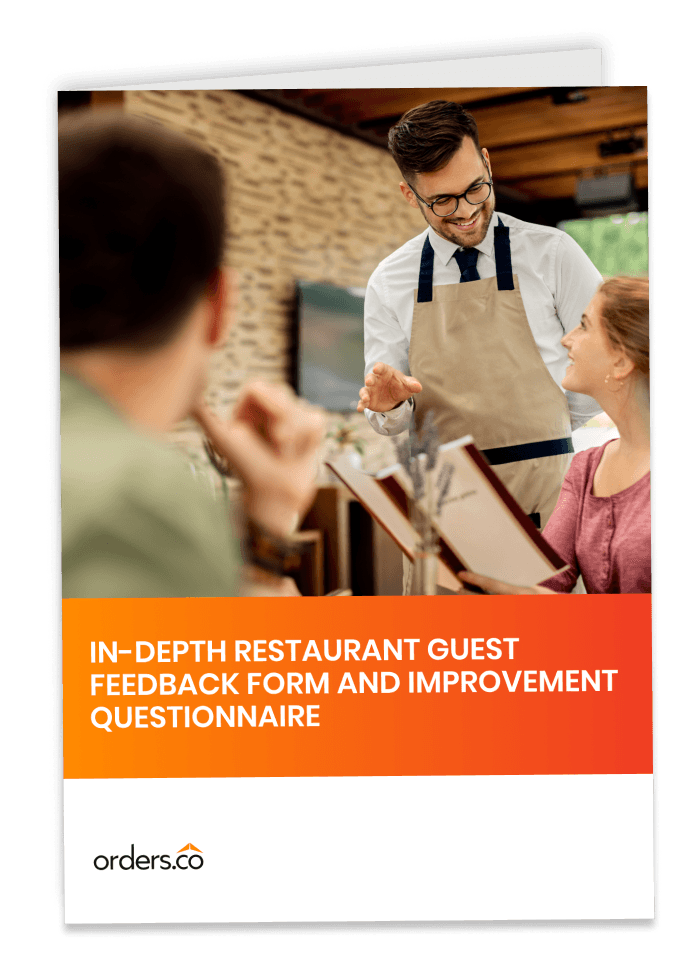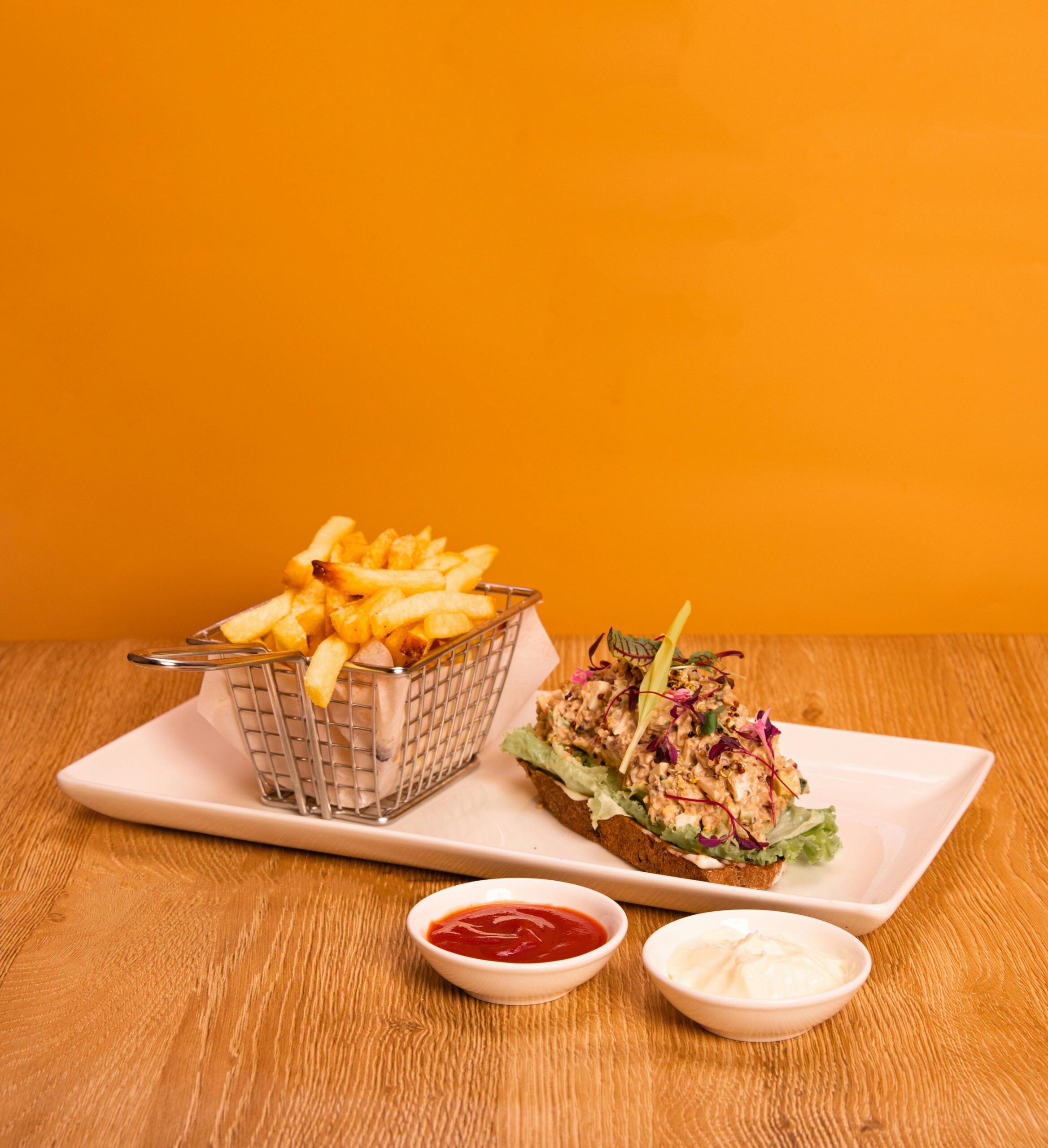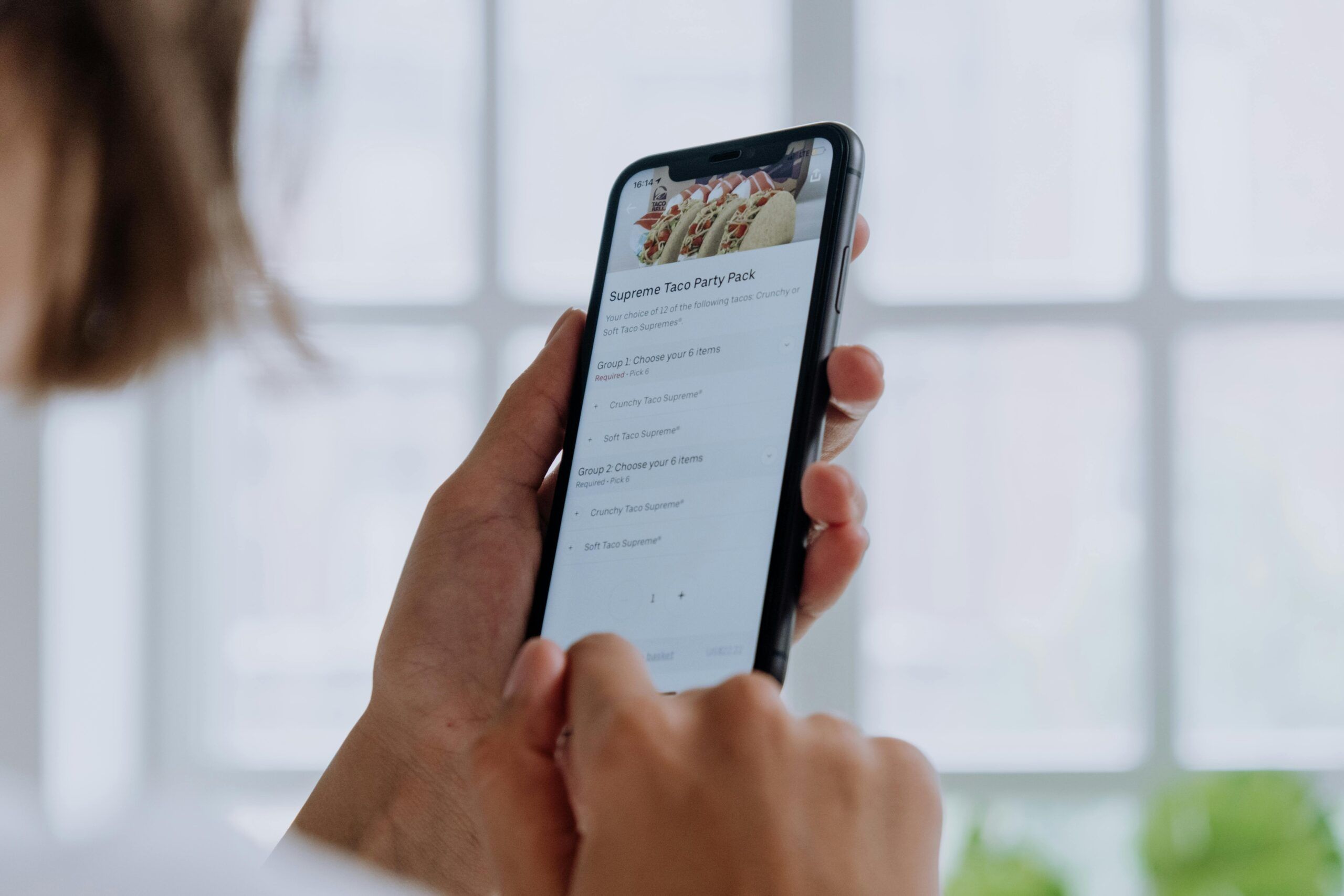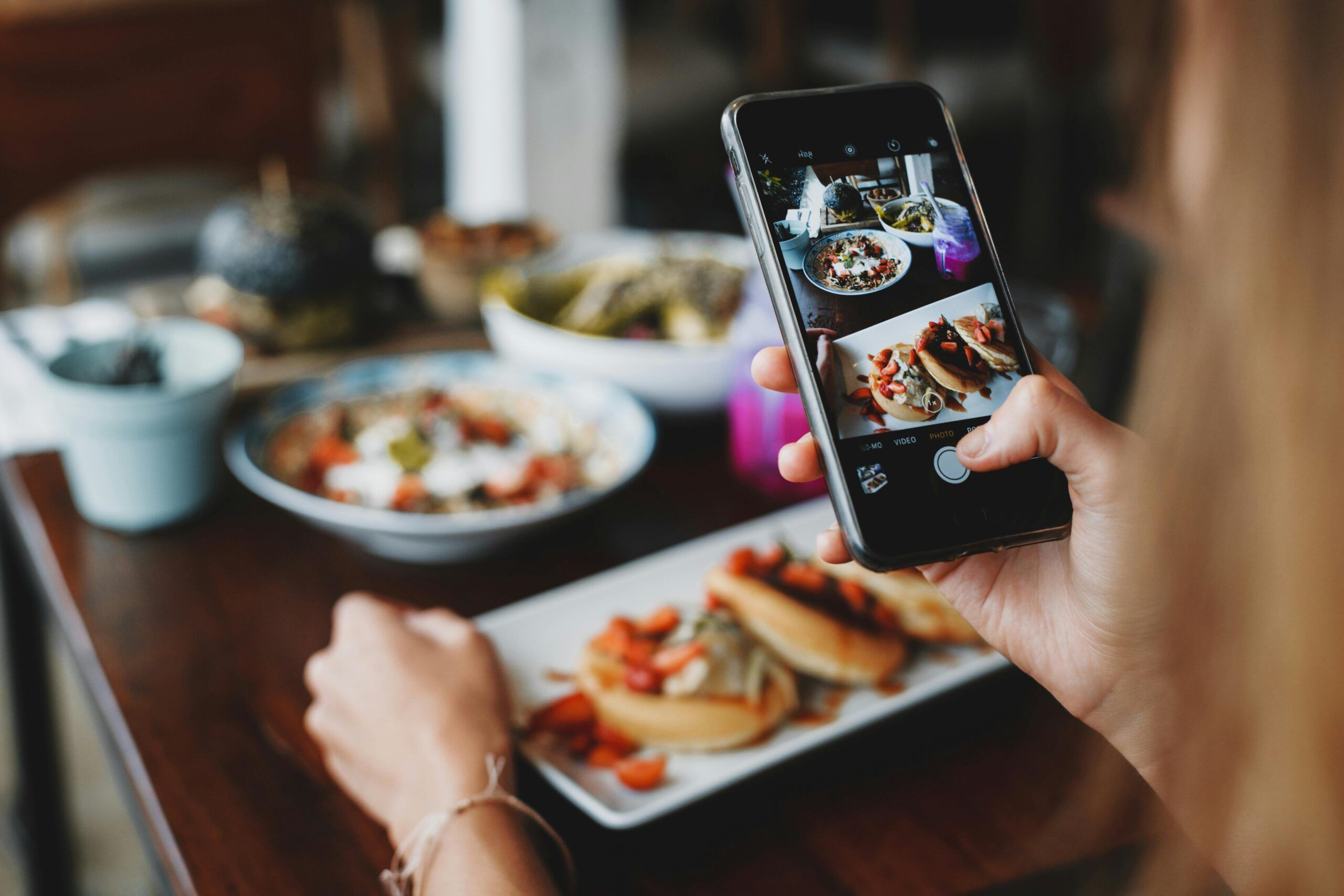- Guest Feedback is The Lifeline of Your Restaurant!
- The Most Effective Ways to Collect Feedback: From Surveys to Websites
- Different Survey Types: Multiple-Choice vs. Open-Ended
- The Key to Reputation Management: Handling Positive and Negative Feedback
- Optimizing Your Menu Through Guest Feedback
- The Role of Guest Feedback in Employee Training
- Final Thoughts: Don’t Just Gather Feedback, Use It
- FAQs
Key Takeaways
- Guest Feedback is Essential. It helps improve customer satisfaction and loyalty by showing that you listen and act on their input.
- Gathering feedback is just the start—use it to make changes that will directly improve your menu, service, and overall experience.
- Use Multiple Channels. Collect feedback through on-site prompts, follow-up emails, and pop-ups for timely, actionable insights.
- Orders.co makes it easy to collect real-time feedback and encourage positive reviews on Google, boosting your online reputation.
More than 90% of unhappy customers will never complain—they’ll just disappear, and they won’t go quietly.
They’ll tell at least 15 people about their bad experience.
In the restaurant industry, this is a disaster waiting to happen.
As a restaurant owner, you might never know the real reason why diners aren’t coming back unless you actively ask them for feedback.
But here’s the twist—you have to do more than just ask.
You need a system to capture, analyze, and act on that feedback to keep your restaurant business thriving.
In this ultimate guide, we’ll show you:
- Why guest feedback is the heart of improving your restaurant’s service and keeping customers coming back.
- How to ask the right questions to get insights that truly matter.
- Simple actions you can take right now to enhance the guest experience and grow your business.
Let’s dive in!
Guest Feedback is The Lifeline of Your Restaurant!
In an industry where first impressions are everything, feedback is your best tool for ensuring that your restaurant delivers on its promise.
Here’s why it matters so much:
1. Customer Satisfaction Starts with Listening
Think of guest feedback as your restaurant’s pulse. It tells you what’s working—and what’s not.
When guests share their thoughts, they provide you with the insight to adjust your services, fix issues before they escalate, and fine-tune the customer experience.
Ignoring it? That’s a fast track to empty tables.
Read Also:
2. Shaping Your Service & Brand Reputation
Guest feedback shapes your restaurant’s long-term reputation.
Online reviews and word-of-mouth are huge decision-makers for potential customers.
A steady stream of positive feedback builds trust and credibility, while unresolved negative experiences can tarnish your brand for good.
- Tip: Responding to feedback (both positive and negative) boosts your brand’s visibility and shows that you care.
This is especially important since 94% of diners will choose your restaurant based on online reviews.
3. Loyalty and Repeat Business Are Built on Feedback
By acting on feedback, you build loyalty and increase the chances of repeat visits.
- 86% of customers are willing to pay more for a better experience. If you listen to what your guests want, you make your restaurant their go-to spot.
The Most Effective Ways to Collect Feedback: From Surveys to Websites
On-Site Feedback Collection: Quick, Direct, and Powerful
One of the most effective ways to get immediate, actionable feedback is by incorporating tools that prompt guests during or directly after their experience.
Here’s how you can leverage on-site feedback collection methods to maximize your insights:
Pop-Ups on Your Website: Capture Real-Time Reactions
This approach takes advantage of the moment when guests are still thinking about their experience.
Why It Works: Guests are more likely to leave meaningful feedback while they’re still engaged with your restaurant.
Tip: Make the pop-up form concise, with questions like: “How satisfied were you with your order?” or “Would you recommend us to a friend?”. Keeping it short encourages more responses and lowers the chances of guests skipping it.
Maximize In-Person Opportunities with Strategic Timing
The key to effective in-person feedback collection is timing. Aim to ask for feedback when the dining experience is still fresh in their minds, but without being intrusive.
This could be:
Immediately After Payment: As guests complete their payment, they’re in a reflective state and open to sharing feedback. Whether through a digital receipt or a printed message on the bottom of the receipt, inviting them to rate their experience works best at this moment quickly.
Post-Order Engagement: You can build feedback prompts when using in-restaurant kiosks or ordering platforms.
As guests finish ordering or leave the kiosk, ask them about their experience—keep it short but meaningful.
Why Simplicity Is Key
Guests will be more willing to give feedback when it’s easy and requires minimal effort.
You don’t want to overwhelm them with a lengthy questionnaire, especially in person.
Focus on collecting quality over quantity in responses.
- Example: “How did we do today?” or “Did we meet your expectations?”. Pair it with a simple rating scale or a yes/no question, and you’re good to go.
Email Feedback: After the Meal is Done
Often, guests may not want to share feedback immediately after their meal but are willing to give more in-depth insights once they’ve had time to reflect on their overall experience.
Personalized Email Requests: How to Make It More Engaging
Making the feedback request feel personal and tailored will greatly increase the likelihood of a response.
Here’s how you can make it work:
- Address the Customer by Name: Including the guest’s name in the email makes the request feel like a conversation rather than an automated response. For example: “Hi Sarah, we hope you enjoyed your dinner with us!” This simple touch can make a big difference in engagement.
- Reference the Guest’s Order: Reminding the guest of their specific meal (or favorite dish) makes the email feel more personal and relevant. “We’d love to hear what you thought about your salmon entrée!” This shows that you care about their individual experience.
- Include a Call to Action: Ask for a simple rating with clear call-to-action buttons that are easy to interact with. Whether it’s a thumbs-up/down or a star rating, providing a one-click option encourages guests to engage without feeling overwhelmed by a lengthy form.
Best Practices for Follow-Up Emails:
- Timing Is Crucial: Send your follow-up emails within 24 hours of the dining experience to ensure the meal is still fresh in the guest’s mind.
- Thank Them for Their Time: A little appreciation goes a long way. In your email, thank the guest in advance for sharing their thoughts. A simple “Thank you for helping us improve!” shows that you value their input and aren’t just sending an automated request.
From Your Custom Ordering Website: Collecting Feedback Seamlessly
At Orders.co, we work closely with restaurants to understand the daily challenges you face—from managing busy shifts to keeping your customers happy.
That’s why we created our Guest Feedback Monitoring feature to help you stay connected with your guests’ thoughts the easiest way possible.
Here’s how it works: Right after someone places an order on your commission-free ordering website, a quick pop-up asks them to rate their experience.
It’s an easy, no-hassle way to capture feedback while it’s still fresh in their minds.
There is no need for complicated setups—everything happens right on your website, so you stay in control.
We also send a follow-up email to gently ask for more detailed feedback on their order and experience.
Plus, we’ll even help you encourage positive reviews on Google, which is a big deal for building your online reputation.
With 87% of customers engaging with businesses with a 3-4 star rating on Google, getting those positive reviews can really help attract new diners.
Different Survey Types: Multiple-Choice vs. Open-Ended
The type of questions you ask plays a crucial role in the quality and usefulness of the insights you gather.
Multiple-Choice Questions: Fast, Quantifiable Insights
Multiple-choice questions are your go-to for gathering quick, actionable data.
Why Use Multiple-Choice Questions?
- Easy to Answer: These questions reduce the mental load on the customer, leading to higher response rates. Guests can quickly select their answers, which makes it a time-efficient way to gather feedback.
- Standardized Data: Because responses are consistent, it’s easier to measure, compare, and analyze trends.

Read Also:
Open-Ended Questions: Deeper, Qualitative Insights
Open-ended questions allow your guests to express their thoughts and experiences in their own words.
This is where you can discover the “why” behind their multiple-choice responses.
Why Use Open-Ended Questions?
- Detailed Feedback: Customers can share specific details, which gives you a richer understanding of what works and needs improvement.
- Uncover Unique Insights: Guests may highlight areas of the experience you hadn’t thought to address, offering new perspectives and suggestions.
Here are 25 open-ended questions that can help gather in-depth insights into your restaurant customers’ experiences.
| Category | Question |
| Overall Experience | 1. What did you enjoy most about your visit today? |
| 2. How would you describe your overall dining experience with us? | |
| 3. What could we do to improve your dining experience next time? | |
| Food Quality | 4. How would you describe the taste and quality of the dishes you ordered? |
| 5. Were there any dishes that you found particularly memorable? Why? | |
| 6. How can we improve the presentation or taste of our food offerings? | |
| Service Quality | 7. How did the service from our staff contribute to your overall experience? |
| 8. Were there any interactions with staff that stood out to you, positively or negatively? | |
| 9. What could our team do to enhance your service experience? | |
| Menu Selection | 10. Are there any menu items you wish we offered? |
| 11. What menu items did you enjoy most, and why? | |
| 12. What would you like to see more of on our menu? | |
| Ambiance and Atmosphere | 13. How did the ambiance of our restaurant enhance or detract from your experience? |
| 14. What would you suggest to improve the atmosphere of our restaurant? | |
| 15. Did you find the seating and layout comfortable? What changes would you suggest? | |
| Takeout/Delivery | 16. How was your experience with our takeout or delivery service? |
| 17. How could we improve our packaging or delivery process to enhance your experience? | |
| 18. What did you like or dislike about ordering from our website? | |
| Customer Satisfaction | 19. What specific element of your visit exceeded your expectations? |
| 20. If there was one thing that didn’t meet your expectations, what was it? | |
| Loyalty and Engagement | 21. How likely are you to return, and what would encourage you to visit more frequently? |
| 22. Have you participated in any of our promotions or loyalty programs? How can we improve them? | |
| Special Occasions | 23. Did you celebrate a special occasion with us? If so, how could we enhance the experience for special events? |
| Recommendations | 24. What would you tell your friends or family about your experience here? |
| 25. What suggestions do you have to make your next visit even better? |
Tip: Consider starting with multiple-choice questions to gather a baseline and then end with an open-ended question to let guests elaborate.
The Key to Reputation Management: Handling Positive and Negative Feedback
Show Appreciation and Amplify the Good
Positive reviews are the foundation of a strong restaurant reputation.
When customers take the time to leave kind words about your restaurant, follow these key steps:
- Thank Them Personally: Don’t just give a generic “thanks.” Address them by name and mention specifics from their review (e.g., a dish they loved).
Example: “Thank you, Sarah! We’re thrilled that you loved our grilled salmon. We can’t wait to serve you again soon!” - Encourage Them to Share: A satisfied customer can become an ambassador for your restaurant. Politely ask them to share their experience on social media or other review platforms.
Tip: You can include a link to your Google Reviews page or social channels to make it easy for them. - Reward Loyal Customers: Consider offering something in return for positive feedback, such as a small discount on their next visit, without making it transactional.
Example: “As a thank-you for your kind words, we’d love to offer you 10% off your next meal with us!”
Read Also:
Turn Negative Feedback into Learning Opportunities
Negative reviews can sting but are also a goldmine for improving your service.
Handling them effectively can turn frustrated customers into loyal patrons.
- Respond Quickly and Calmly: Address negative feedback with empathy and professionalism. Acknowledge their experience and show that you’re committed to making it right.
Example: “We’re sorry to hear about your experience, James. We appreciate your feedback and would love the chance to make things right.” - Offer a Solution: Whenever possible, offer a tangible solution to their issue. Whether it’s a refund, replacement meal, or personal follow-up, show that you’re proactive about resolving problems.
Example: “We’d like to invite you back for a complimentary meal so we can provide the experience you deserve.” - Learn and Improve: Use negative feedback as an opportunity to refine your service. Look for patterns in complaints and make necessary changes to avoid recurring issues.
Pro Tip: If you notice frequent feedback about long wait times or dish quality, those areas should become priorities for improvement.
Read Also:
Optimizing Your Menu Through Guest Feedback
Guest feedback offers invaluable insights that can help you continuously refine your restaurant menu. By analyzing feedback, you can spot trends that might otherwise go unnoticed.
For example:
Track Popular Dishes: Do you notice recurring praise for specific items? This can help you identify your best-sellers. Consider highlighting them on your menu or featuring them in promotions.
Tip: You might even experiment with seasonal variations of these favorites to keep things fresh while maintaining customer loyalty.
Identify Gaps: On the flip side, repeated feedback about missing items or dietary needs can highlight gaps in your menu.
Are customers frequently asking for more vegetarian, gluten-free, or kid-friendly options? Use this information to expand your offerings and accommodate a wider audience.
Pro Tip: Don’t wait for trends to pass. If you see multiple requests for a plant-based option, adding a vegan dish could be your next big hit.
Portion Sizes & Pricing: Feedback about portion sizes—whether too large or too small—can guide adjustments. If guests feel they aren’t getting value for their money, they might not return.
Listening to feedback about portions can help you hit the sweet spot between satisfaction and cost-efficiency.
Example: “We’ve adjusted the portion size of our pasta dishes based on our restaurant customer feedback, ensuring every plate offers great value.”
The Role of Guest Feedback in Employee Training
Guest feedback is also one of the most powerful tools for shaping your team’s performance.
Pinpoint Areas for Improvement: Frequent feedback about slow service or lack of attentiveness signals a clear opportunity for improvement.
This allows you to fine-tune training for your team, ensuring they better meet customer expectations.
Customize Training: Use feedback to craft targeted sessions.
For example, if customers regularly mention how certain dishes are served incorrectly, hold a training session to ensure staff fully understand menu details.
Focus on Soft Skills: If feedback consistently points out unfriendly or inattentive service, you can prioritize hospitality training to emphasize creating welcoming and memorable guest experiences.
Example: “Based on recent feedback, we’re focusing this month’s training on improving table-side manner and enhancing efficiency during busy hours.”
Address Peak Time Struggles: Guest complaints about overwhelmed staff during peak hours can help you identify the need for more efficiency training, such as multi-tasking techniques or better communication between kitchen and waitstaff.
Read Also:
How Guest Feedback Informs Staff Development
| Feedback Theme | Training Focus | Action Plan |
| Slow Service During Lunch Hours | Speed & Efficiency | Implement a workshop on managing time during busy periods and setting priorities. |
| Unfriendly or Cold Attitude | Hospitality & Soft Skills | Create role-playing scenarios to practice better communication and body language. |
| Incorrect Order Deliveries | Menu Knowledge & Accuracy | Host a quiz-style training on the menu items and preparation times. |
| Inconsistent Attention to Guests | Attentiveness & Multi-Tasking | Use real guest feedback to simulate situations that require balancing tasks. |
| Issues with Special Requests | Accommodating Dietary Preferences | Conduct a session on effectively managing special orders and guest requests. |
Pro Tip: Utilize guest feedback surveys to identify which staff members receive consistently positive reviews and which need additional support.
This approach allows you to personalize training for each employee.
Final Thoughts: Don’t Just Gather Feedback, Use It
Collecting feedback is just the first step. The real power comes from actively using that feedback to shape your restaurant’s offerings and service.
Orders.co Guest Feedback Monitoring is designed to make collecting and using feedback super easy for your restaurant.
When a customer places an order on your custom restaurant website, they’ll see a quick pop-up asking for their thoughts—right after the experience, when it’s still fresh.
But that’s not all! After their meal, Orders.co sends a follow-up email to check in, asking them to rate the order.
Another friendly email encourages satisfied customers (4 stars and up) to leave a positive review on Google, helping boost your restaurant’s online reputation without any extra effort on your part.
This means you’re always in the loop about how customers feel, and you can act on feedback in real time to keep improving.
Ready to give it a try?
Schedule a demo and see how Orders.co can help you improve customer satisfaction and grow your restaurant’s reputation.
FAQs
Why is restaurant customer feedback so important?
Restaurant customer feedback helps you understand what guests appreciate and what areas need improvement. Acting on this feedback improves customer satisfaction, boosts loyalty, and helps you stay competitive in a rapidly changing industry.
How can I collect customer feedback in my restaurant?
You can gather feedback in various ways: on-site pop-ups after an order is placed, printed surveys on receipts, digital feedback requests, or follow-up emails. For example, Orders.co allows you to automate feedback collection directly from your custom ordering website.
What are some restaurant feedback questions I can ask?
Popular restaurant feedback questions include:
- “How satisfied were you with your overall experience?”
- “What dish did you enjoy the most?”
- “How can we improve our service?” Keeping questions simple and relevant ensures higher response rates.
How do I create a restaurant feedback form?
When creating a restaurant feedback form, focus on a balance of multiple-choice and open-ended questions. Include inquiries about food quality, service, ambiance, and overall experience to gather well-rounded insights.
How can Orders.co help me manage restaurant feedback?
Orders.co offers a seamless Guest Feedback Monitoring feature. It collects real-time feedback through pop-up forms on your custom ordering website and follows up with emails, encouraging positive reviews on Google to improve your restaurant’s online reputation.
What should I do with negative restaurant feedback?
Respond quickly and calmly to negative feedback. Acknowledge the issue, apologize, and offer a solution. Negative feedback is a great opportunity to learn and improve, turning unhappy customers into loyal guests.
What are some effective ways to ask for restaurant customer feedback?
Use multiple channels like post-order pop-ups, follow-up emails, or a restaurant feedback form. Timing is crucial—asking for feedback immediately after the dining experience or via a follow-up email ensures fresher responses.
How do I get more feedback for my restaurant?
Encourage feedback by making it easy for guests to respond. Use short, targeted surveys and offer incentives like discounts for completed feedback. Orders.co helps by sending follow-up emails after every order, increasing response rates.
Can guest feedback improve my menu?
Absolutely. Guest feedback often highlights popular dishes or gaps in your menu. By analyzing this feedback, you can introduce new items, adjust portion sizes, or accommodate dietary preferences based on customer demand.




